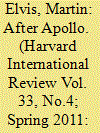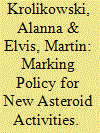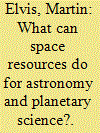| Srl | Item |
| 1 |
ID:
119883


|
|
|
|
|
| Publication |
2011.
|
| Summary/Abstract |
Just over 200 years ago an American president initiated a program of exploration that sent two men to the Pacific Ocean. Fifty years ago, another American president initiated a program of exploration that sent two men to the Sea of Tranquility. Fifty years after Lewis and Clark we had the California Gold Rush, and it was just another 16 years to the completion of the first transcontinental railroad with the Golden Spike. But fifty years after the beginning of the Apollo Program, the New Frontier of space has been trailing far behind the pace of the frontier of the American West. Why the striking contrast?
|
|
|
|
|
|
|
|
|
|
|
|
|
|
|
|
| 2 |
ID:
169291


|
|
|
|
|
| Summary/Abstract |
Several national governments have recently taken substantial steps toward creating policies that apply to new, path-breaking activities at asteroids in outer space. Near-term activities on asteroids are likely to be various, including mining initiated by private firms and planetary defense activities pursued by public agencies. Current perspectives on making policy toward asteroid activities often presume that the different goals pursued by actors interested in asteroids are mutually supportive and that diverse actors’ common focus on asteroids builds momentum for creating an enabling policy environment. In contrast, we argue that the 4 main categories of asteroid activities envisioned today—scientific research (science), human settlement of other parts of the solar system (settlement), planetary defense (security), and mining (sales)—are best served by policy regimes with distinct features. Different activities require different policy arrangements, which are not straightforwardly compatible. The incompatibilities present policymakers with trade-offs. This article discusses the 4 main types of asteroid activities and their related policy needs to highlight these trade-offs and influence debate.
|
|
|
|
|
|
|
|
|
|
|
|
|
|
|
|
| 3 |
ID:
157164


|
|
|
|
|
| Summary/Abstract |
The Outer Space Treaty makes it clear that the Moon is the ‘province of all mankind’, with the latter ordinarily understood to exclude state or private appropriation of any portion of its surface. However, there are indeterminacies in the Treaty and in space law generally over the issue of appropriation. These indeterminacies might permit a close approximation to a property claim or some manner of ‘quasi-property’. The recently revealed highly inhomogeneous distribution of lunar resources changes the context of these issues. We illustrate this altered situation by considering the Peaks of Eternal Light. They occupy about one square kilometer of the lunar surface. We consider a thought experiment in which a Solar telescope is placed on one of the Peaks of Eternal Light at the lunar South pole for scientific research. Its operation would require non-disturbance, and hence that the Peak remain unvisited by others, effectively establishing a claim of protective exclusion and de facto appropriation. Such a telescope would be relatively easy to emplace with today’s technology and so poses a near-term property issue on the Moon. While effective appropriation of a Peak might proceed without raising some of the familiar problems associated with commercial development (especially lunar mining), the possibility of such appropriation nonetheless raises some significant issues concerning justice and the safeguarding of scientific practice on the lunar surface. We consider this issue from scientific, technical, ethical and policy viewpoints.
|
|
|
|
|
|
|
|
|
|
|
|
|
|
|
|
| 4 |
ID:
148488


|
|
|
|
|
| Summary/Abstract |
The rapid cost growth of flagship space missions has created a crisis for astronomy and planetary science. We have hit the funding wall. For the past 3 decades scientists have not had to think much about how space technology would change within their planning horizon. However, this time around enormous improvements in space infrastructure capabilities and, especially, costs are likely on the 20-year gestation periods for large space telescopes. Commercial space will lower launch and spacecraft costs substantially, enable cost-effective on-orbit servicing, cheap lunar landers and “interplanetary cubesats” by the early 2020s. A doubling of flagship launch rates is not implausible. On a longer timescale it will enable large structures to be assembled and constructed in space. These developments will change how we plan and design missions.
|
|
|
|
|
|
|
|
|
|
|
|
|
|
|
|